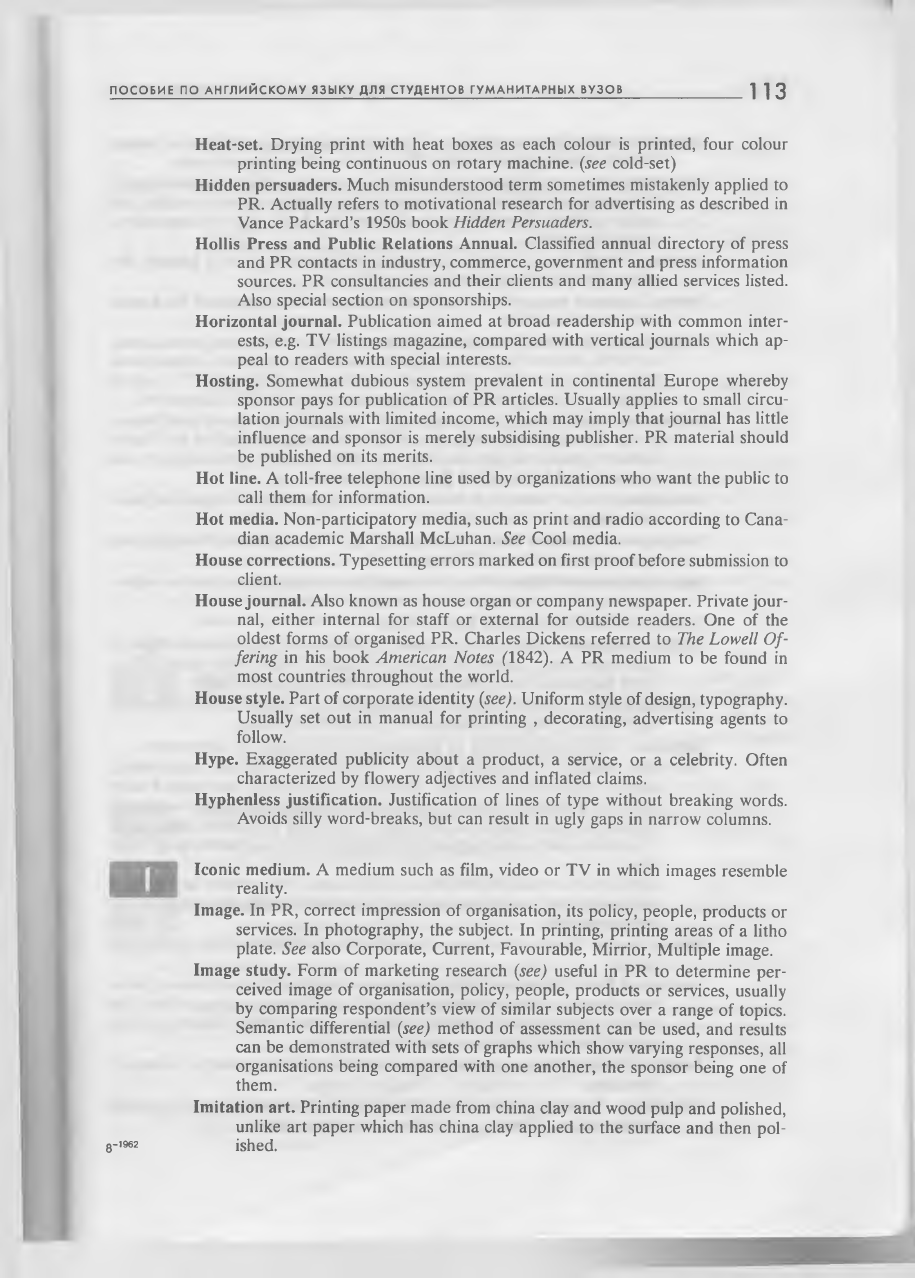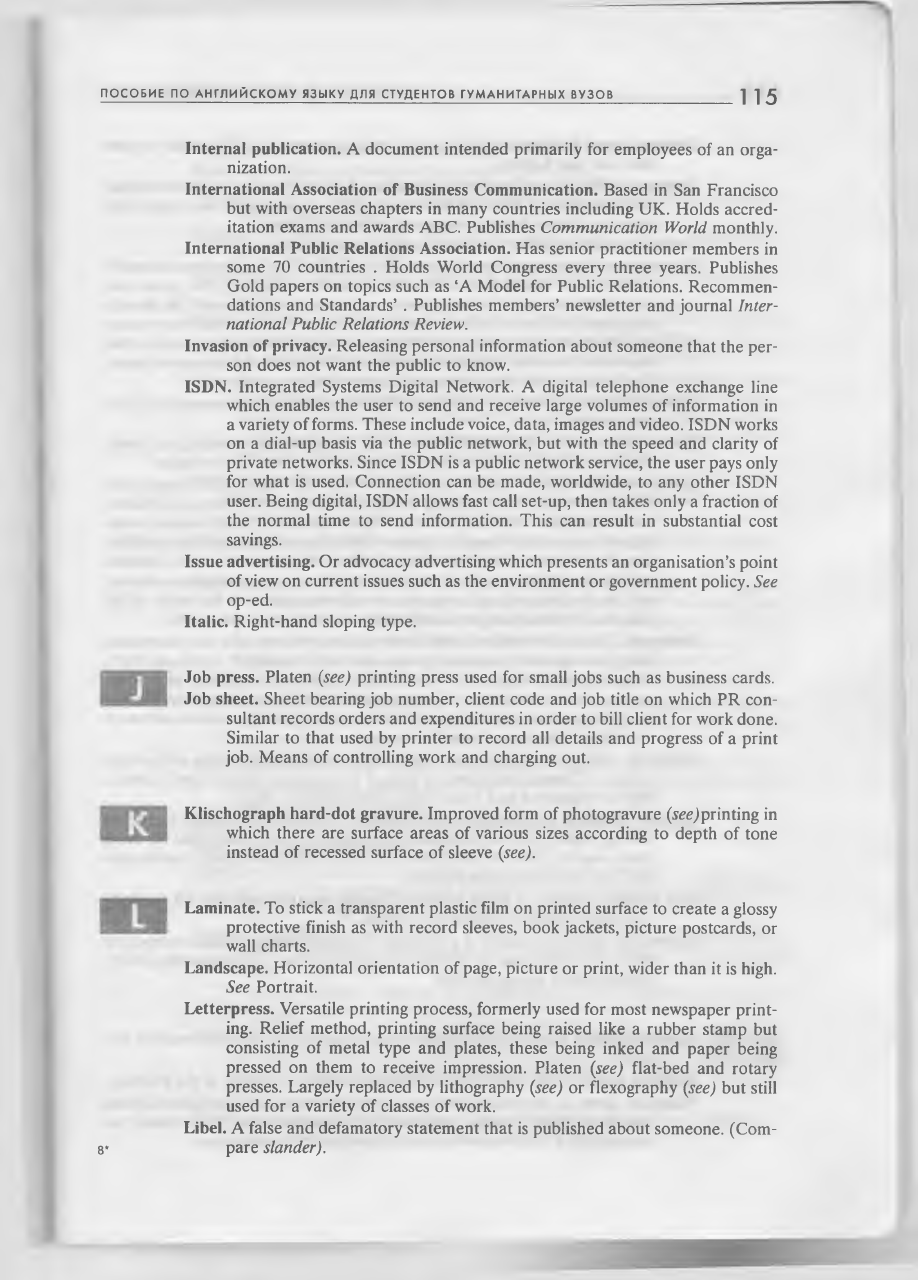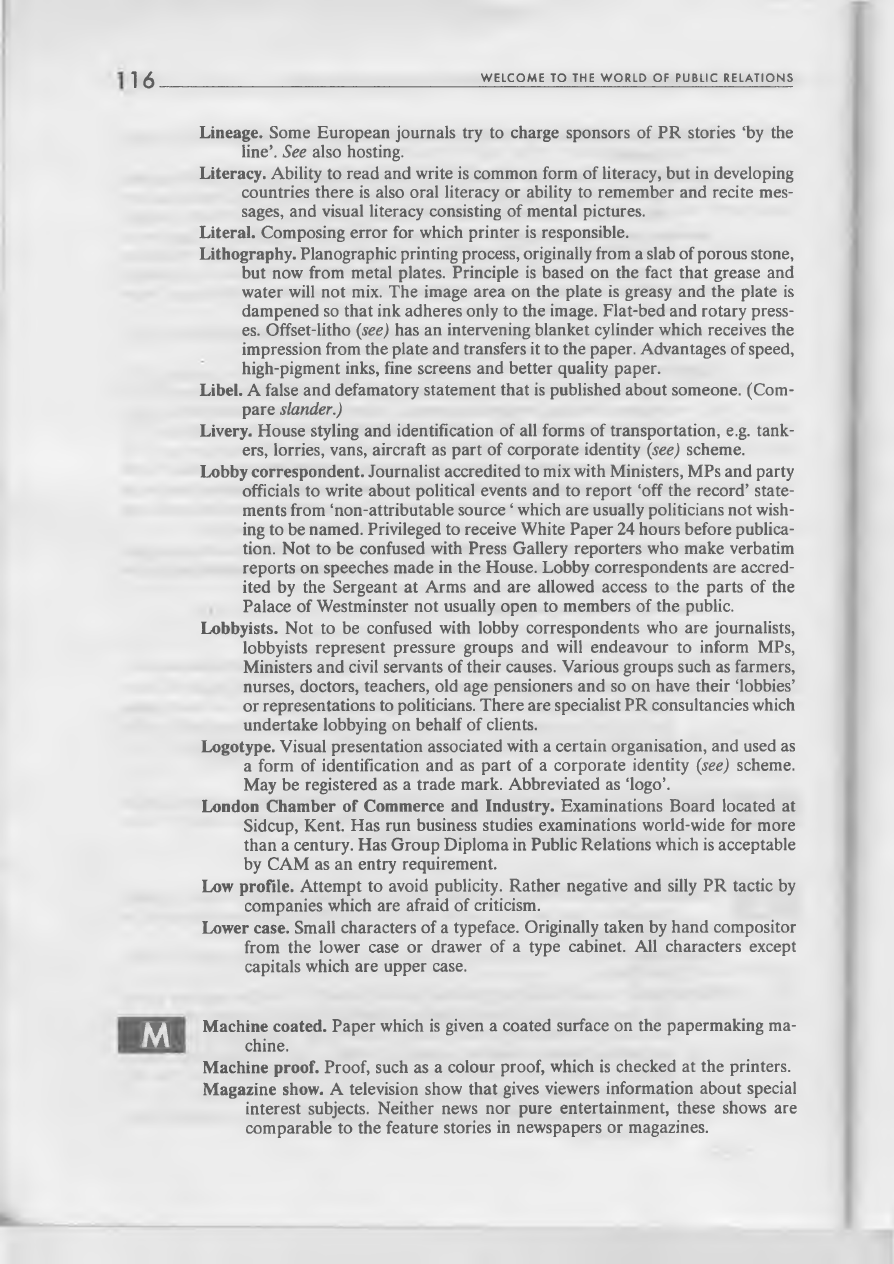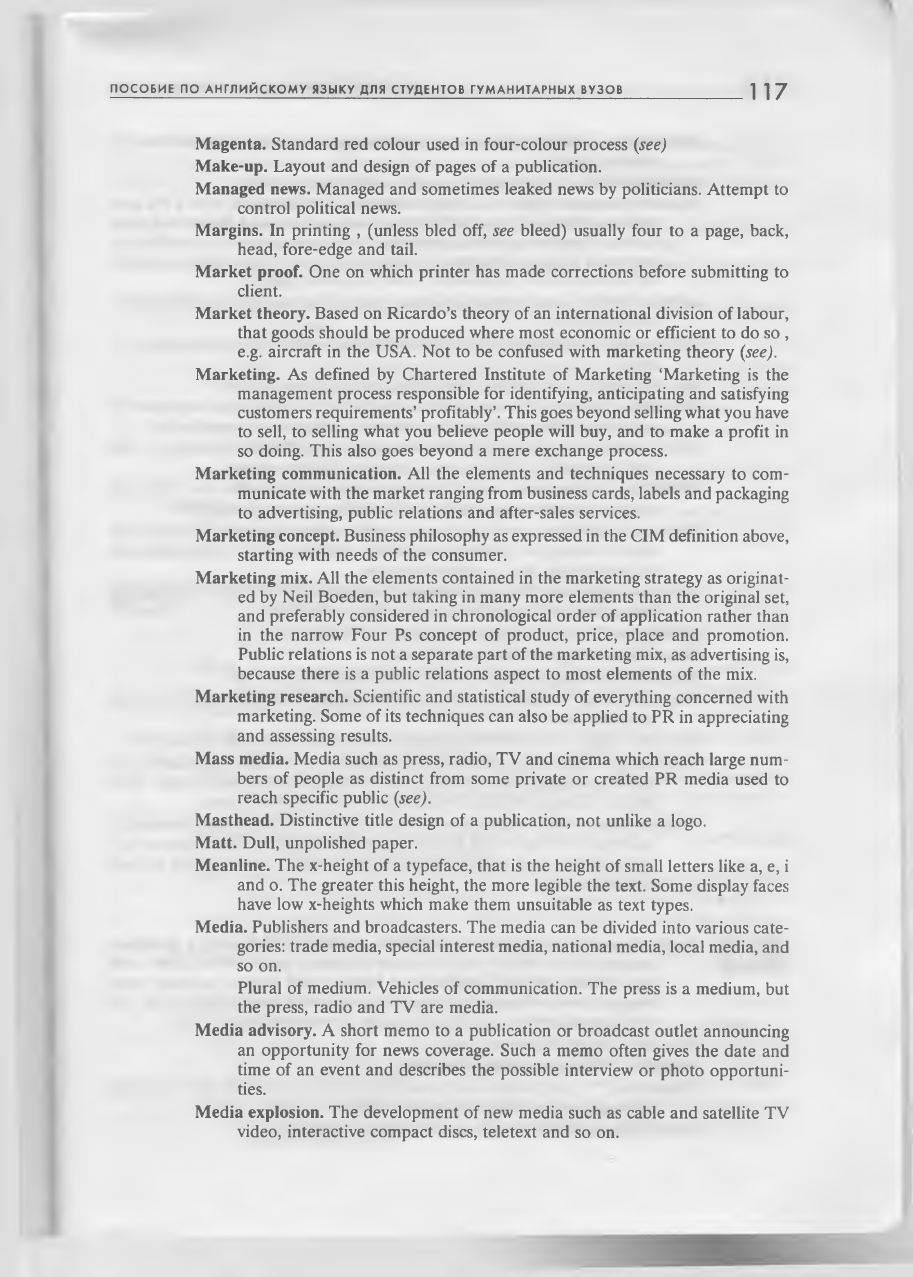ВУЗ: Не указан
Категория: Не указан
Дисциплина: Не указана
Добавлен: 01.04.2021
Просмотров: 1449
Скачиваний: 7

П О С О Б И Е П О А Н Г Л И Й С К О М У Я З Ы К У Д Л Я С Т У Д Е Н Т О В Г У М А Н И Т А Р Н Ы Х В У З О В
113
Heat-set.
Drying print with heat boxes as each colour is printed, four colour
printing being continuous on rotary machine,
(see
cold-set)
Hidden persuaders.
Much misunderstood term sometimes mistakenly applied to
PR. Actually refers to motivational research for advertising as described in
Vance Packard’s 1950s book
Hidden Persuaders.
Hollis Press and Public Relations Annual.
Classified annual directory of press
and PR contacts in industry, commerce, government and press information
sources. PR consultancies and their clients and many allied services listed.
Also special section on sponsorships.
Horizontal journal.
Publication aimed at broad readership with common inter
ests, e.g. TV listings magazine, compared with vertical journals which ap
peal to readers with special interests.
Hosting.
Somewhat dubious system prevalent in continental Europe whereby
sponsor pays for publication of PR articles. Usually applies to small circu
lation journals with limited income, which may imply that journal has little
influence and sponsor is merely subsidising publisher. PR material should
be published on its merits.
Hot line.
A toll-free telephone line used by organizations who want the public to
call them for information.
Hot media.
Non-participatory media, such as print and radio according to Cana
dian academic Marshall McLuhan.
See
Cool media.
House corrections.
Typesetting errors marked on first proof before submission to
client.
House journal.
Also known as house organ or company newspaper. Private jour
nal, either internal for staff or external for outside readers. One of the
oldest forms of organised PR. Charles Dickens referred to
The Lowell O f
fering
in his book
American Notes
(1842). A PR medium to be found in
most countries throughout the world.
House style.
Part of corporate identity
(see).
Uniform style of design, typography.
Usually set out in manual for printing , decorating, advertising agents to
follow.
Hype.
Exaggerated publicity about a product, a service, or a celebrity. Often
characterized by flowery adjectives and inflated claims.
Hyphenless justification.
Justification of lines of type without breaking words.
Avoids silly word-breaks, but can result in ugly gaps in narrow columns.
Iconic medium.
A medium such as film, video or TV in which images resemble
reality.
Image.
In PR, correct impression of organisation, its policy, people, products or
services. In photography, the subject. In printing, printing areas of a litho
plate.
See
also Corporate, Current, Favourable, Mirrior, Multiple image.
Image study.
Form of marketing research
(see)
useful in PR to determine per
ceived image of organisation, policy, people, products or services, usually
by comparing respondent’s view of similar subjects over a range of topics.
Semantic differential
(see)
method of assessment can be used, and results
can be demonstrated with sets of graphs which show varying responses, all
organisations being compared with one another, the sponsor being one of
them.
Imitation art.
Printing paper made from china clay and wood pulp and polished,
unlike art paper which has china clay applied to the surface and then pol-
8~1962
ished.

114
W E L C O M E T O T H E W O R L D O F P U B L I C R E L A T I O N S
Imposition table.
One on which artwork and typesettings can be laid or pasted
down for photography to make litho plate or photogravure sleeve.
Impression.
Pressure of inked printing plate on paper to achieve a printed copy.
The impression cylinder holds paper against printing plate or, in litho, the
blanket cylinder. Complete run or edition of a book, e.g. first impression,
second impression.
Imprint.
Usually found at foot of last page of a piece of print to identify the
printer. Provides legal proof in case of dispute.
Indent.
To start a paragraph with a blank space, as with conventional book style
(see).
Aids readability.
Independent Television Commission.
Replaced IBA in 1991 under Broadcasting
Act 1990. Awards licences to commercial ITV contractors. Administers
ITC Code of Advertising Standards and Practice. Publishes ITC Code of
Programme Sponsorship. Stations represented by the ITV Association.
Independent local radio.
Commercial radio. Originally introduced into Britain
by the Sound Broadcasting Act 1972, but now controlled by the Radio
Authority under the Broadcasting Act 1990. Stations represented by the
Association of Independent Radio Contractors.
Independent Radio News.
IRN. News service for commercial independent local
radio stations.
Independent Television News.
Owned partly by ITV contractors. Provides news
such as
News A t Ten
to ITV stations.
Induction material.
Material for new recruits to an organisation, such as video
cassettes, slide presentations and company literature.
Industrial film.
Documentary film or video.
In-flight magazines.
Magazines published by airlines and distributed in-flight to
passengers, being placed in fixtures on backs of seats. More than 100 in
flight magazines, many produced for airlines by specialist firms.
Informal leaders.
Leaders of special interest groups, or village leaders in develop
ing countries. May act as innovator.
See
innovator theory.
In-house.
Work handled within an organisation as ‘in-house PR department’.
Innovator theory.
Or dispersion theory . An innovator tries and recommends.
Early adopters take up the idea, followed by late majority who copy. Finally
there are the more reluctant, conservative-minded laggards who eventually
become adopters. Useful in PR where a new idea or product depends on
this process, and widely applicable in both developed and developing coun
tries.
Used by McCormick in Mid-West of USA in mid-19th century farm trials of
machinery, but also in modern times to promote family planning in devel
oping countries.
Insider trader.
Person who misuses sensitive financial information for his own
benefit.
Institute of Public Relations.
British professional body for PR practitioners. Mem
bers elected on basis of experience and CAM Diploma or equivalent. Has
Code of Professional Conduct. Publishes journal
Public Relations
.Holds
annual Sword of Excellence awards competition.
Intaglio.
Printing from a recessed image as with copper engraving or photogra
vure
(see).
Interleaves.
Sheets of paper, often flimsy, inserted between pages to provide
protection, or to prevent set-off from wet printed sheets.

П О С О Б И Е П О А Н Г Л И Й С К О М У Я З Ы К У Д Л Я С Т У Д Е Н Т О В Г У М А Н И Т А Р Н Ы Х В У З О В
115
Internal publication.
A document intended primarily for employees of an orga
nization.
International Association of Business Communication.
Based in San Francisco
but with overseas chapters in many countries including UK. Holds accred
itation exams and awards ABC. Publishes
Communication World
monthly.
International Public Relations Association.
Has senior practitioner members in
some 70 countries . Holds World Congress every three years. Publishes
Gold papers on topics such as ‘A Model for Public Relations. Recommen
dations and Standards’ . Publishes members’ newsletter and journal
Inter
national Public Relations Review.
Invasion of privacy.
Releasing personal information about someone that the per
son does not want the public to know.
ISDN.
Integrated Systems Digital Network. A digital telephone exchange line
which enables the user to send and receive large volumes of information in
a variety of forms. These include voice, data, images and video. ISDN works
on a dial-up basis via the public network, but with the speed and clarity of
private networks. Since ISDN is a public network service, the user pays only
for what is used. Connection can be made, worldwide, to any other ISDN
user. Being digital, ISDN allows fast call set-up, then takes only a fraction of
the normal time to send information. This can result in substantial cost
savings.
Issue advertising.
Or advocacy advertising which presents an organisation’s point
of view on current issues such as the environment or government policy.
See
op-ed.
Italic.
Right-hand sloping type.
Job press.
Platen
(see)
printing press used for small jobs such as business cards.
Job sheet.
Sheet bearing job number, client code and job title on which PR con
sultant records orders and expenditures in order to bill client for work done.
Similar to that used by printer to record all details and progress of a print
job. Means of controlling work and charging out.
Klischograph hard-dot gravure.
Improved form of photogravure
(see)
printing in
which there are surface areas of various sizes according to depth of tone
instead of recessed surface of sleeve
(see).
Laminate.
To stick a transparent plastic film on printed surface to create a glossy
protective finish as with record sleeves, book jackets, picture postcards, or
wall charts.
Landscape.
Horizontal orientation of page, picture or print, wider than it is high.
See
Portrait.
Letterpress.
Versatile printing process, formerly used for most newspaper print
ing. Relief method, printing surface being raised like a rubber stamp but
consisting of metal type and plates, these being inked and paper being
pressed on them to receive impression. Platen
(see)
flat-bed and rotary
presses. Largely replaced by lithography
(see)
or flexography
(see)
but still
used for a variety of classes of work.
Libel.
A false and defamatory statement that is published about someone. (Com-
8*
pare
slander).

16
W E L C O M E T O T H E W O R L D O F P U B L I C R E L A T I O N S
Lineage.
Some European journals try to charge sponsors of PR stories ‘by the
line’.
See
also hosting.
Literacy.
Ability to read and write is common form of literacy, but in developing
countries there is also oral literacy or ability to remember and recite mes
sages, and visual literacy consisting of mental pictures.
Literal.
Composing error for which printer is responsible.
Lithography.
Planographic printing process, originally from a slab of porous stone,
but now from metal plates. Principle is based on the fact that grease and
water will not mix. The image area on the plate is greasy and the plate is
dampened so that ink adheres only to the image. Flat-bed and rotary press
es. Offset-litho
(see)
has an intervening blanket cylinder which receives the
impression from the plate and transfers it to the paper. Advantages of speed,
high-pigment inks, fine screens and better quality paper.
Libel.
A false and defamatory statement that is published about someone. (Com
pare
slander.)
Livery.
House styling and identification of all forms of transportation, e.g. tank
ers, lorries, vans, aircraft as part of corporate identity
(see)
scheme.
Lobby correspondent.
Journalist accredited to mix with Ministers, MPs and party
officials to write about political events and to report ‘off the record’ state
ments from ‘non-attributable source ‘ which are usually politicians not wish
ing to be named. Privileged to receive White Paper 24 hours before publica
tion. Not to be confused with Press Gallery reporters who make verbatim
reports on speeches made in the House. Lobby correspondents are accred
ited by the Sergeant at Arms and are allowed access to the parts of the
Palace of Westminster not usually open to members of the public.
Lobbyists.
Not to be confused with lobby correspondents who are journalists,
lobbyists represent pressure groups and will endeavour to inform MPs,
Ministers and civil servants of their causes. Various groups such as farmers,
nurses, doctors, teachers, old age pensioners and so on have their ‘lobbies’
or representations to politicians. There are specialist PR consultancies which
undertake lobbying on behalf of clients.
Logotype.
Visual presentation associated with a certain organisation, and used as
a form of identification and as part of a corporate identity
(see)
scheme.
May be registered as a trade mark. Abbreviated as ‘logo’.
London Chamber of Commerce and Industry.
Examinations Board located at
Sidcup, Kent. Has run business studies examinations world-wide for more
than a century. Has Group Diploma in Public Relations which is acceptable
by CAM as an entry requirement.
Low profile.
Attempt to avoid publicity. Rather negative and silly PR tactic by
companies which are afraid of criticism.
Lower case.
Small characters of a typeface. Originally taken by hand compositor
from the lower case or drawer of a type cabinet. All characters except
capitals which are upper case.
M
Machine coated.
Paper which is given a coated surface on the papermaking ma
chine.
Machine proof.
Proof, such as a colour proof, which is checked at the printers.
Magazine show.
A television show that gives viewers information about special
interest subjects. Neither news nor pure entertainment, these shows are
comparable to the feature stories in newspapers or magazines.

П О С О Б И Е П О А Н Г Л И Й С К О М У Я З Ы К У Д Л Я С Т У Д Е Н Т О В Г У М А Н И Т А Р Н Ы Х В У З О В
117
Magenta.
Standard red colour used in four-colour process
(see)
Make-up.
Layout and design of pages of a publication.
Managed news.
Managed and sometimes leaked news by politicians. Attempt to
control political news.
Margins.
In printing , (unless bled off,
see
bleed) usually four to a page, back,
head, fore-edge and tail.
Market proof.
One on which printer has made corrections before submitting to
client.
Market theory.
Based on Ricardo’s theory of an international division of labour,
that goods should be produced where most economic or efficient to do so ,
e.g. aircraft in the USA. Not to be confused with marketing theory
(see).
Marketing.
As defined by Chartered Institute of Marketing ‘Marketing is the
management process responsible for identifying, anticipating and satisfying
customers requirements’ profitably’. This goes beyond selling what you have
to sell, to selling what you believe people will buy, and to make a profit in
so doing. This also goes beyond a mere exchange process.
Marketing communication.
All the elements and techniques necessary to com
municate with the market ranging from business cards, labels and packaging
to advertising, public relations and after-sales services.
Marketing concept.
Business philosophy as expressed in the CIM definition above,
starting with needs of the consumer.
Marketing mix.
All the elements contained in the marketing strategy as originat
ed by Neil Boeden, but taking in many more elements than the original set,
and preferably considered in chronological order of application rather than
in the narrow Four Ps concept of product, price, place and promotion.
Public relations is not a separate part of the marketing mix, as advertising is,
because there is a public relations aspect to most elements of the mix.
Marketing research.
Scientific and statistical study of everything concerned with
marketing. Some of its techniques can also be applied to PR in appreciating
and assessing results.
Mass media.
Media such as press, radio, TV and cinema which reach large num
bers of people as distinct from some private or created PR media used to
reach specific public
(see).
Masthead.
Distinctive title design of a publication, not unlike a logo.
M att. Dull, unpolished paper.
Meanline.
The x-height of a typeface, that is the height of small letters like a, e, i
and o. The greater this height, the more legible the text. Some display faces
have low x-heights which make them unsuitable as text types.
Media.
Publishers and broadcasters. The media can be divided into various cate
gories: trade media, special interest media, national media, local media, and
so on.
Plural of medium. Vehicles of communication. The press is a medium, but
the press, radio and TV are media.
Media advisory.
A short memo to a publication or broadcast outlet announcing
an opportunity for news coverage. Such a memo often gives the date and
time of an event and describes the possible interview or photo opportuni
ties.
Media explosion.
The development of new media such as cable and satellite TV
video, interactive compact discs, teletext and so on.